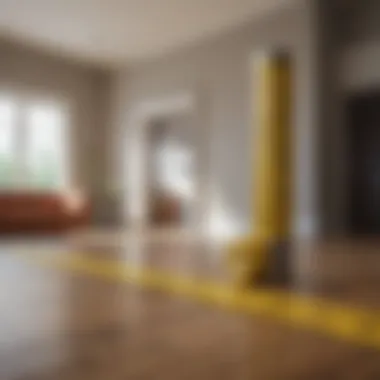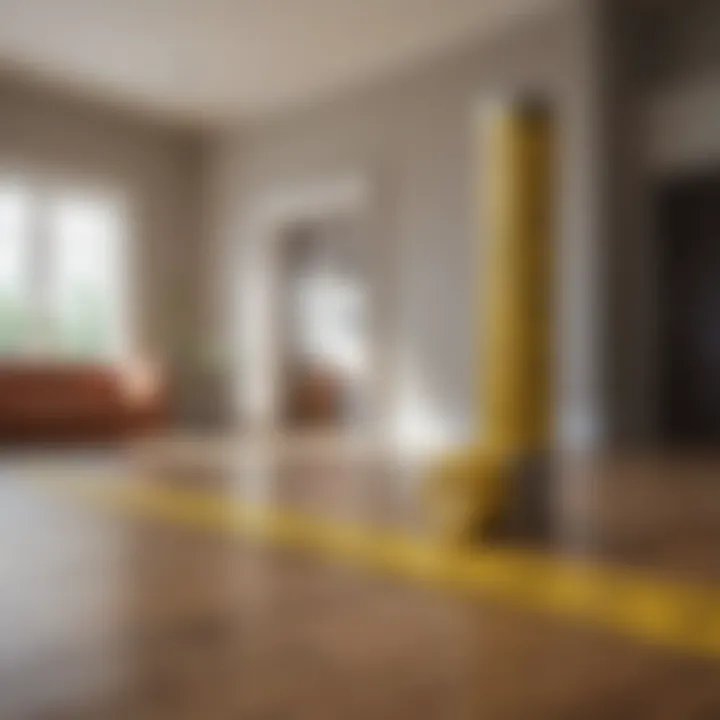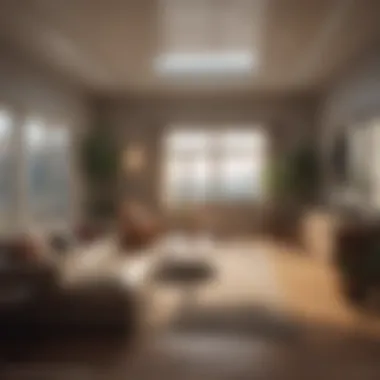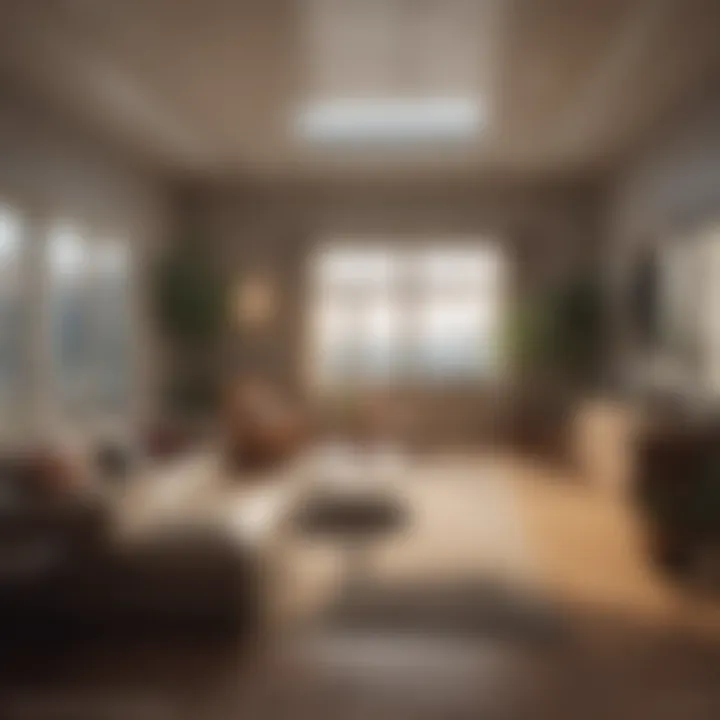Calculating Square Footage of a Room: A Comprehensive Guide


Intro
Understanding how to accurately calculate the square footage of a room is essential for homeowners, designers, and real estate professionals alike. Precise measurements not only help in design and planning but also play a crucial role in property valuation and renovations. When calculating square footage, it is vital to consider various factors that can influence measurements, particularly when dealing with irregularly shaped rooms.
Feature Spotlight
Efficient Measurement Techniques
A reliable first step is to choose the appropriate measuring technique. The most common methods include:
- Standard Measurement: This technique applies to rectangular or square rooms, where length and width are straightforward to determine.
- L-Shape Measurement: For L-shaped rooms, divide the space into two rectangles, calculate each area, and then sum them.
- Triangular and Circular Areas: For odd shapes, some basic formulas can help. For instance, the area of a triangle is calculated as 1/2 × base × height, while a circle's area is π × radius².
Tools for Accurate Measurement
Using the right tools enhances measurement accuracy tremendously. Here are some essential items:
- Tape Measure: A reliable 25-foot tape measure is essential for general measuring tasks.
- Laser Measure: For larger spaces, a laser distance meter provides quick and precise measurements, eliminating human error during the process.
- Graph Paper: Sketching the room layout on graph paper can aid visualization, particularly for oddly shaped areas.
Considerations for Irregularly Shaped Rooms
When measuring irregular rooms, subtle details such as alcoves, nooks, and recessed areas require special attention. Here are a few considerations to maximize accuracy:
- Segmental Approach: Break the room into manageable sections, even combining more complex shapes into simpler forms.
- Visual Checks: Measure more than once and cross-verify to avoid discrepancies, especially in larger spaces.
- Ceiling and Wall Features: Remember that features such as built-in shelves and wall projections should also be considered in the final calculation.
"Accuracy in measurements begins before the tape even touches the floor. Before starting, plan the approach and aim for precision every step of the way."
Practical Applications of Square Footage Calculations
Accurate room measurements have far-reaching implications. Here are a few ways in which they are particularly significant:
- Renovation Planning: Knowing the precise area aids in choosing the right materials and estimating costs effectively.
- Interior Design: Designers utilize square footage to create efficient layouts that maximize function and aesthetics. Additionally, they can better understand how furniture will fit into a space.
- Real Estate Valuation: Accurate measurements are crucial for assessing property value. Buyers and sellers alike focus on square footage to determine pricing.
Each of these considerations demonstrates the importance of meticulousness in square footage calculation. Achieving an accurate figure enhances not only one’s understanding of space but also the experience of living or working within it.
Understanding Square Footage
Understanding square footage is essential for multiple reasons. It serves as the starting point for various tasks, whether one is buying, selling, or renovating a property. Having a clear grasp on the dimensions of a room greatly impacts decisions regarding furnishings, design layouts, and even the overall usability of a space.
Knowing the square footage can help homeowners and real estate professionals calculate the total area accurately. It aids in understanding the potential of a room for purposes like hosting, storage, or planning renovations. This knowledge is vital for interior design aficionados who must ensure their space feels appropriate and functional. Furthermore, when dealing with real estate transactions, precise measurements can influence property valuation and marketability.
Accurate square footage measurements also have legal implications, particularly for real estate documentation, as they often determine compliance with building codes and zoning laws. This guide aims to unravel the nuances of calculating square footage, making it a valuable resource for all interested parties.
Definition of Square Footage
Square footage refers to the total area of a room measured in square feet. It is computed by multiplying the length of a room by its width. For example, if a bedroom measures 12 feet in length and 10 feet in width, its square footage would be 120 square feet (12 x 10). This measurement is fundamental to determine how much space one has for placement of furniture, ease of movement, and accessibility.
The square footage is not just a number; it embodies the potential of a space. Understanding how to calculate it allows individuals to make informed decisions, ensuring that they utilize their available space effectively and to its fullest.
Importance of Accurate Measurements
Accurate measurements are crucial when calculating square footage. Minor mistakes can lead to significant discrepancies, ultimately affecting both functionality and aesthetic appeal. Here are some key points to consider:
- Space Optimization: Correct measurements enable better planning of furniture placement and design layout, enhancing functionality.
- Budgeting: Knowing the precise square footage helps in estimating costs for flooring, painting, and other renovations.
- Legal Compliance: Accurate measurements ensure adherence to local building standards and regulations, preventing legal issues.
Moreover, inaccuracies can mislead potential buyers or renters, impacting negotiations in real estate scenarios. Precise calculations help build trust and credibility, whether in personal projects or professional assessments.
"A small mistake in measurement can lead to big problems in design and functionality."
Tools Required for Measurement
When it comes to accurately calculating the square footage of a room, the tools you choose play a critical role in ensuring precision. The right measuring tools not only facilitate accurate data collection, but also enhance the overall measurement process. In this section, we will discuss the various tools necessary for measurement, outlining their benefits and the specific considerations to keep in mind when selecting these tools.
Measuring Tape
A measuring tape is a fundamental tool in any measuring arsenal. It is portable, easy to use, and widely available. Typically made of flexible metal or plastic, measuring tapes can extend to various lengths. When selecting a measuring tape, consider the length you may need. For most rooms, a tape measure that extends to at least 25 feet is sufficient.


Using a measuring tape is straightforward: extend the tape along the length of the wall or floor, ensuring it is taut for an accurate reading. Be mindful to record measurements with attention to the markings – each increment counts. Also, when handling tape measure, the ability to lock it in place is beneficial for ease of use during measurement.
Laser Distance Measurer
A laser distance measurer represents a modern advancement in measurement technology. These devices utilize laser technology to determine distances with remarkable precision. The user simply points the device at a target, presses a button, and the measurement is displayed digitally.
One major advantage of a laser distance measurer is its ability to provide quick and accurate results without the need for physical contact with the surfaces being measured. This is especially useful for high ceilings or inaccessible areas. While these tools can be more expensive than traditional measuring tapes, the efficiency and accuracy they offer make them worthwhile investments for serious projects. Regular calibration is crucial to ensure consistent accuracy.
Graph Paper
Using graph paper can be immensely helpful during the measuring process, particularly for planning and visualizing room layouts. Graph paper allows for a scaled representation of the room dimensions. Each box on the paper can represent a specific measurement, making it easier to see how different elements will fit together.
Before using graph paper, make sure to determine the scale you will use. For example, one square could represent one square foot. Once you have established a scale, you can accurately sketch walls, doors, and windows. This physical representation aids in understanding spatial relationships and optimizing room layouts.
Remember, accurate measurements begin with the right tools. Choosing the tools that align with your needs can lead to successful project outcomes.
Basic Measurement Techniques
Understanding basic measurement techniques is vital for ensuring accuracy in square footage calculations. These techniques lay the foundation for both simple and complex measurements that can be useful in various applications, from home renovations to real estate assessments. By mastering these methods, individuals can avoid common errors that lead to miscalculations, ultimately saving time and resources.
Measuring Rectangular Areas
When measuring a rectangular space, the process is straightforward yet crucial. To begin, identify the length and width of the area. Use a measuring tape or laser distance measurer to obtain exact figures. It’s essential to measure from one end to the other, ensuring the tape remains straight during the process.
Once you have the dimensions, apply the formula for square footage:
Square Footage = Length x Width
This simple multiplication provides an accurate area measurement.
For example, if a room measures 12 feet in length and 10 feet in width, the square footage calculations would be:
12 ft x 10 ft = 120 sq ft.
This technique is applicable to various settings, such as determining the size of a living room, bedroom, or kitchen.
Calculating Square Footage
Accurate square footage calculations are essential in many practical scenarios. These scenarios can dictate design choices and impact real estate transactions. In any calculation of square footage, ensure that the dimensions taken reflect the space being measured without any overlooked details.
Considerations must also include any fixtures, such as wall coverings or furniture which may occupy space but do not contribute to the functional area. In an instance where a room features alcoves or recesses, those should be accounted for separately.
For example, if a room contains a 2 x 3 foot alcove, its area will add an additional 6 square feet to the measurement, which is calculated as follows:
Area of alcove = Length x Width
Area of alcove = 2 ft x 3 ft = 6 sq ft
Thus, continuing from the previous example of the room, the total square footage would now rise to:
120 sq ft + 6 sq ft = 126 sq ft.
To sum up, precise square footage calculations depend on both measuring skills and a clear understanding of how to apply measurement techniques in various contexts.
"Accurate square footage calculations can significantly impact design, proposals, and valuations."
By grasping these basic measurement techniques, individuals can confidently assess room sizes, making informed decisions in home and commercial environments.
Measuring Irregularly Shaped Rooms
Measuring irregularly shaped rooms presents unique challenges that require careful consideration and methods tailored to account for their complexity. Unlike rectangular or square spaces, these rooms may feature various angles, alcoves, and extensions that can easily complicate hard measurements. As homeowners or professionals seeking to understand square footage, it’s crucial to recognize the importance of accuracy in these scenarios. Accurate measurements can significantly impact renovation costs, real estate evaluations, and overall spatial planning.
Implementing systematic strategies allows one to efficiently capture the overall dimensions of these non-standard shapes, ensuring that no area is overlooked. In this section, we will discuss effective techniques that streamline the measurement process and provide reliable results.
Dividing the Space into Sections
A practical approach to measuring irregular spaces is to divide the room into manageable sections. This method simplifies calculations and reduces the chance of errors. Here are steps to effectively divide the room:
- Visual Assessment: Stand at a central point and observe the room. Identify natural divisions, such as corners or lines formed by furniture.
- Segment Identification: Break the room down into recognizable shapes. For example, a rectangular section combined with a triangular section can give a clearer picture of the overall area.
- Measurement Application: Use a measuring tape or laser distance measurer to gather dimensions of each identified segment. Ensure to measure lengths and widths accurately.
- Total Area Calculation: After measuring each section, calculate the area for each. For rectangles, use the formula length × width. For triangles, apply the formula 0.5 × base × height.
By dividing the room into sections, you create a more organized way to tackle measurements. This structured approach not only aids calculations but also increases confidence in accuracy.
Using Geometric Calculations
When measuring irregular spaces, utilizing geometric calculations is vital for ensuring precision. These calculations can help transform complex shapes into simpler, quantifiable units. Here are some methods to consider:
- Pythagorean Theorem: Ideal for finding missing sides in right triangles. If you have the lengths of two sides, the third can be calculated using the formula ( a^2 + b^2 = c^2 ), where c is the hypotenuse. This theorem is particularly useful in awkward spaces where traditional measurements may be difficult.
- Composite Area Method: For rooms with multiple irregular sections, apply the previously discussed segmentation method, then sum up the areas calculated for each segment. This method enables accurate assessment of overall space.
- Trapezoidal Rule: When dealing with curved or sloped sections, the trapezoidal rule offers a more accurate area estimation. For two parallel segments of a shape, the formula ( A = 0.5 × (b_1 + b_2) × h ) can be applied to calculate the area, where b_1 and b_2 are the lengths of the parallel sides, and h is the height.
By incorporating these geometric methods, you enhance the accuracy of your measurements even in complex layouts.
Understanding how to effectively measure irregularly shaped rooms is crucial for achieving precise square footage calculations. Employing strategies like dividing the space into sections and utilizing geometric calculations can transform what seems daunting into an achievable task.
These techniques equip homeowners, designers, and real estate professionals with the necessary tools to succeed in their projects.


Calculating Area of Complex Shapes
Calculating the area of complex shapes can often be a challenge for many individuals. Understanding these techniques is especially important when dealing with irregular rooms or spaces that do not conform to standard shapes. By employing specific mathematical principles, one can achieve accurate measurements that facilitate effective room planning, renovation projects, or real estate assessments. These calculations are crucial not only for ensuring precision but also for maximizing the utility of space in various environments. This section will outline methods such as the Pythagorean Theorem and the Trapezoidal Rule, providing a framework to help simplify these potential complexities.
Applying the Pythagorean Theorem
The Pythagorean Theorem is a fundamental principle in geometry and plays a vital role in calculating the area of complex shapes. This theorem states that in a right triangle, the square of the hypotenuse length is equal to the sum of the squares of the other two sides. This relationship can help break down irregular shapes into manageable right triangles, enabling easier area computation.
To effectively use the Pythagorean Theorem:
- Identify the right triangles within the complex shape.
- Measure the lengths of the two legs of each triangle.
- Apply the theorem to calculate the length of the hypotenuse, if necessary:Hypotenuse = √(a² + b²)Where a and b are the lengths of the two legs.
- Use established formulas to calculate the area of the triangles:Area of Triangle = (1/2) × base × height
By summing the areas of all identified triangles, the total area of the complex shape can be determined. This method is practical for spaces that can be visualized as a combination of right triangles, ensuring accuracy in measurement while accommodating various design requirements.
Using the Trapezoidal Rule
The Trapezoidal Rule is another effective technique for calculating the area of complex shapes, particularly those that can be approximated by trapezoids. This rule derives from integral calculus and provides a way to estimate the area under a curve, or in this case, within an irregular outline.
To apply the Trapezoidal Rule:
- Divide the shape into trapezoidal sections. This may involve identifying parallel sides within the complex shape.
- Measure the lengths of the two parallel sides (let's denote them as a and b).
- Measure the height of each trapezoid.
- Use the following formula to calculate the area of each trapezoid:Area = (1/2) × (a + b) × height
- Sum the areas of all trapezoids to obtain the total area.
This method is particularly advantageous when working with longer, irregular dimensions, offering a more simplified approach to what might otherwise be overly complicated. Utilizing the Trapezoidal Rule can enhance accuracy in calculating complex areas, making it a valuable approach for various practical applications in areas such as home design and real estate evaluations.
"Accurate measurements of complex shapes can save time and money in any renovation or design project."
The mastery of these advanced measuring techniques unlocks the ability to handle a diverse range of spatial configurations and prepares individuals to engage with complex design tasks confidently.
Common Mistakes to Avoid
Measuring the square footage of a room is a task that seems straightforward but can lead to significant errors. Understanding common mistakes is crucial in achieving accurate measurements. These errors can affect numerous aspects of home design, renovations, and real estate assessments. Identifying and avoiding these pitfalls ensures that one gains a solid understanding of the space in question.
Neglecting to Account for Outlets and Windows
One prevalent mistake is overlooking the placement of outlets, windows, and doors. When measuring for square footage, it is easy to focus solely on the floor area and ignore these elements. While they may seem minor, accounting for outlets and windows is essential for two main reasons.
First, these features often affect the functionality of a room. For instance, in interior design, placement of furniture can be limited by windows and outlets, impacting how a space is utilized. Second, accurately measuring square footage without considering these features can lead to overestimating available space. This can result in an inaccurate assessment, which might affect decisions regarding renovations.
To avoid this mistake, measure around windows and outlets. Consider marking these locations on your graph paper or digital mapping tool to keep track of their positions. This practice ensures a more precise calculation of usable space.
Misrecording Measurements
Another frequent error is the misrecording of measurements during the process. In the hustle of taking notes or entering data into an app, it is easy to transpose numbers or mix up dimensions. This can lead to either exaggerated or reduced square footage calculations, which may affect project planning or budgeting.
Maintaining accuracy in recording requires some care. Here are a few suggestions to prevent this error:
- Use a consistent method: Whether using a tape measure or laser distance measurer, stick with one measurement style throughout the task.
- Double-check measurements: Always take a moment to verify recorded numbers against the original measurements. This can mean recalibrating the measurement tool or asking someone to assist you in confirming results.
- Keep a dedicated log: Create a clear document or digital file where all measurements are stored. This prevents scattered notes and allows for easier reference.
Each step in measuring square footage is critical. Avoiding these common mistakes will lead to better efficiency and correctness in your calculations, ultimately enhancing the overall outcome of your project.
Using Measurement Apps and Tools
As technology continues to advance, measuring a room no longer requires solely traditional methods with a tape measure. The emergence of measurement apps and tools has provided homeowners, designers, and real estate professionals with innovative solutions for calculating square footage. These apps simplify the process, allowing for quick calculations and accurate measurements. Moreover, they help minimize human error, a common issue in manual measuring processes.
Overview of Popular Apps
Several measurement apps have gained prominence due to their user-friendly features and effectiveness. Some of the notable ones include:
- Magicplan: This app allows users to create floor plans by taking pictures of a room. It generates accurate measurements and even offers 3D modeling options.
- RoomScan Pro: With this app, you can measure rooms just by walking around them. It uses the smartphone's sensors to create accurate floor plans.
- Measure: Developed by Google, Measure uses augmented reality (AR) technology to allow users to measure objects and spaces just by pointing their device’s camera at the area in question.
Each of these applications has its unique strengths, enabling diverse methods for effective room measurement. Choosing the right app depends on individual needs and desired features, but all can significantly enhance accuracy and efficiency in measuring square footage.
Benefits of Digital Measurement
The shift to digital tools for measuring rooms presents several clear advantages:


- Precision: Digital measurements can reduce human error, leading to more precise results.
- Speed: Measurement apps provide near-instantaneous results, eliminating the need for cumbersome calculations.
- Visualization: Many apps offer graphical representations, helping you visualize the space more effectively.
- Convenience: With mobile apps, you have a measuring tool in your pocket, making it readily accessible whenever needed.
In summary, using measurement apps and tools streamlines the process of calculating square footage and ensures accuracy. They offer unique capabilities that cater to different user needs, whether for renovation projects or assessing property dimensions. As the landscape of measurement continues to evolve, embracing these technological solutions can lead to better planning and decision-making in space management.
"Digital measurement tools are not just convenient; they can transform the way we understand and interact with our spaces."
Practical Applications of Square Footage
Understanding square footage goes beyond just academic interest. It holds significant practical applications across various fields. This section emphasizes the role of accurate square footage calculation in home renovations and real estate assessments, detailing the direct benefits and potential pitfalls.
Home Renovations
Square footage plays a critical role in home renovations. When homeowners decide to remodel or expand their living spaces, knowing the exact square footage helps in planning. It informs material requirements and costs. Different materials, like flooring or paint, are often priced per square foot. Thus, having precise measurements allows for accurate budgeting.
Moreover, the layout of a renovation can depend on the square footage. For instance, a living room may need different furnishing arrangements based on its dimensions. Accurate square footage calculation facilitates optimal design decisions and functionality.
Renovations that exceed budget often result from unexpected material costs. Homeowners can prevent this by using correct calculations from the onset. Detailed understanding of square footage can also enhance the efficiency of space usage. When square footage is clear, design solutions tailored to the specific space can be developed.
Real Estate Assessments
In the real estate market, square footage is an essential component for property valuation. Accurate measurements are crucial for both buyers and sellers. A property’s square footage impacts its assessed value and pricing. When sellers list their properties, an accurate measurement helps to set a competitive price without undervaluing or overvaluing the property.
Buyers, on the other hand, rely on square footage to evaluate potential purchases. Knowledge of square footage informs their expectations regarding space and comfort. An adequately measured property can lead to informed negotiations. Misrepresentation in square footage can result in trust issues and possibly legal ramifications.
Furthermore, real estate agents routinely perform market comparisons. Correct square footage enables them to offer informed suggestions to their clients. Inaccuracies can skew market analysis and affect sales outcomes. Consequently, ensuring accurate square footage becomes not only a practice of integrity but also a necessity for market competency.
Accurate square footage is more than a calculation; it is a practice that underpins successful transactions in real estate.
Advanced Measurement Techniques
In the realm of measuring spaces, advanced techniques play a significant role. They elevate the process from mere calculations to precise determinations of room dimensions, ensuring accuracy that is crucial for various purposes. Understanding and applying these methodologies can enhance the effectiveness of measuring not only for homeowners but also for professionals in fields like real estate and interior design.
With the growing complexity of building designs and the diversity of environments, mastering advanced measurement techniques is essential. It allows users to incorporate additional factors such as height and volume, offering a more holistic view of space.
Incorporating Height in Volume Calculations
When discussing square footage, height may seem irrelevant. However, it introduces a new dimension—literally. Calculating volume becomes paramount when dealing with spaces like garages, warehouses, and other multi-functional areas. This requires an understanding of height alongside length and width.
To calculate volume, the formula is straightforward:
Volume = Length x Width x Height.
Each measurement must be precise. For example, if a room is 10 feet long, 12 feet wide, and 8 feet high, the calculation would yield a volume of 960 cubic feet. This can affect how you design the space later during renovations or staging for sale.
Furthermore, calculating volume helps in figuring out airspace for HVAC systems, which is pivotal in home comfort and energy efficiency.
Getting Accurate Measurements in Different Environments
Variation in environments often presents challenges in measurement. Non-standard surfaces, outdoor areas, and unconventional room layouts require special considerations.
For instance, measuring outdoors can introduce elements like uneven terrain or obstacles. Using a laser distance measurer can significantly aid in these situations, as it provides quick and accurate readings from a distance. This tool is particularly helpful in getting measurements without needing to physically touch every point.
In interior spaces, elements like furniture can obstruct your ability to take clear measurements. It may require moving items to accurately assess the size of the room. Alternatively, using graph paper to sketch can help visualize the area and clarify any issues that arise with dimensions.
"Clear and precise measurements serve as the foundation for any successful project in design or real estate."
Ultimately, developing a systematic approach to measuring in various environments ensures consistency. It increases the reliability of your data and supports your calculations, whether for personal projects or professional assessments. Understanding and applying these advanced techniques contributes greatly towards accuracy and effectiveness in determining square footage.
Ending
The conclusion of this article serves as a crucial element in summarizing the main insights and practical applications of calculating square footage. Understanding the square footage of a room is not merely an academic exercise; it has real implications for renovation projects, real estate transactions, and space management in a multitude of environments.
Accurate measurements enhance decision-making, ensuring that any adjustments or purchases made for space serve their intended purpose effectively. Flawed measurements can lead to wasted time, resources, and potentially significant financial losses. Therefore, the importance of thorough and precise calculations cannot be overstated.
Summary of Key Points
- Understanding Square Footage: Recognizing what square footage is and why it's necessary for various applications.
- Measuring Tools: Employing the right tools, like laser distance measurers and measuring tapes, caters to varying measurement needs.
- Techniques Overview: Applying basic and advanced measurement techniques ensures no space is too complex to calculate.
- Practical Applications: Knowing how to measure square footage can influence decisions in home renovation projects and real estate assessments.
The synthesis of these elements provides clarity and reinforces the importance of careful, methodical measurement practices.
Encouragement for Accurate Measurement Practices
Being meticulous in measurement practices should be a priority for anyone dealing with space-related projects. Establishing a routine of double-checking measurements adds a layer of reliability. Invest in quality tools and familiarize oneself with using them to minimize errors. Measurements are foundational to planning and execution in design, construction, and real estate.
Embracing technology, such as measurement apps, can also streamline the process, making it more efficient. More importantly, fostering a habit of precision cultivates a greater appreciation for spatial planning and usage.
"Precision is not just a skill; it is a discipline that enhances the quality of any undertaking."







